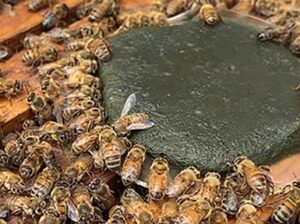by Dewey M. Caron, Communications and Content Specialist for the Oregon Master Beekeeper Program
 Blue-green algal diet
Blue-green algal diet
Have you heard about a new bee diet of blue-green algae? It reportedly helps in control of Deformed Wing virus (DWV). DWV reaches epidemic levels when varroa mites feed on adult fat body and developing bee pupae and is responsible for a large proportion of our heavy overwintering colony losses.
So should we scoop up pond scum to mix into our protein patties? The ‘rest of the story’ says no. Although blue-green algae has a nutritional profile similar to that of pollen, the algae in question has been genetically engineered by a team of scientists, led by Dr. Vincent Ricigliano of the USDA Baton Rouge Bee lab. The engineered blue-green algal cells produce genetic code that targets DWV, preventing the virus from hijacking the bee cells (viruses are the ultimate parasites – they need living cells so they can live and reproduce). When this genetically engineered blue-green algae is fed to bees, previously injected with DWV, bee lifespans were extended protecting them from the severe effects of DWV.
The Betterbee newsletter details this development and discusses how genetic engineering might continue to be incorporated into beekeeping in the future. Find this primer using your search engine to download: Genetic Engineering Our Way to Bee Health?
 Bee talk
Bee talk
The bee hive is a noisy, humid, dark, smelly place. So how do worker bees talk to their sister bees? We know chemicals are pretty important. Sound too is used to pass messages, for example in dances and for scouts to prepare bees to leave with a swarm. Additionally, in their close quarters, bees constantly touch other bees. Antennal contact it turns out is also pretty important.
A new study from University of Edinburgh in Scotland documents that bees use their antennae to help interpret the information communicated by dancing bees. This helps refine the message and to inform hive mates of food and new home sites on a crowded dance floor. It is estimated that scout bees will dance to indicate an average of 10 new possible nest sites before the swarm emerges/while at the bivouac site. The bees must reach a consensus about their new site. Worker antennae refines the message.
The study used slow motion, high resolution film under infrared light to track the position of the antennae of the bees that were following waggle dancers, which are otherwise a blur to the naked human eye. The antennae repeatedly touch the dancer as it waggles by. The potential recruit uses gravity position information of its own body, integrating it with antennal information from the position of the dancer. It then accurately adds together the two angles detected from its two sensory systems to determine what direction (relative to sun) and how far it needs to fly (so it can take enough fuel reserves to get there and back home).
Employing a computer model that replicates known brain circuits in the bee, the researchers showed that fewer than one hundred neurons are needed to integrate this information and determine the angle and the distance to the home site/food being signaled in a waggle dance. PhD student Anna Hadjitofi, who did the study, said: “This is particularly exciting because it unveils a remarkably elegant neural mechanism employed by bees to decipher complex information with minimal resources”.
Once again we marvel about how honey bees are able to function so well in their world with a simple yet elegant system. https://www.cell.com/current-biology/pdfExtended/S0960-9822(24)00220-3
 Estimating colony numbers
Estimating colony numbers
The USDA, NASS 2022 Ag Census reported a record high 3.8 million honey bee colonies in the United States, an increase of 25% over the last bi-decade census. Can that be true? Are colony numbers increasing so dramatically in the US?
These USDA numbers directly contradict the same agency’s own yearly colony number reports – estimates have been between 2.5 and 2.9 million for years. https://www.nass.usda.gov/Surveys/Guide_to_NASS_Surveys/Bee_and_Honey/
One of the ”reasons” given is a reported increase in hobbyists. Doing the math, it would take 250,000 more hobbyists to account for an additional 1 million more colonies, assuming hobbyists keep on average 4 colonies (hobbyists keep between 3 and 4 colonies on average according to the PNW honey bee survey). Seems highly unlikely.
So what might explain the number increase? The numbers came from the recent US Ag census. The 5-year Ag Census methodology includes surveying farms which “host” colonies. This might explain the “increase” since commercial beekeepers are migratory and farmers sending back their surveys might be reporting numbers of commercial colonies n their individual farms; hobbyist beekeepers would not likely be getting an Ag census request form. Did you receive one? Did you fill it out? Only 61% were returned.
Commercial beekeeper Chris Hiatt, President of the American Honey Producers Association (AHPA), after viewing the numbers indicated the incentive to grow colony numbers includes an insufficient colony number to meet pollination contracts and elevated honey demand (met by imports). However he also said: “Over the past 10-plus years, most beekeepers’ business strategy has focused on making up for the previous year’s losses …. It is nearly impossible to make up for the losses, much less increase the colony count.”
It seems colony numbers, contrary to the ag census, have not dramatically increased.
Photo: Chris Hiatt CA apiary